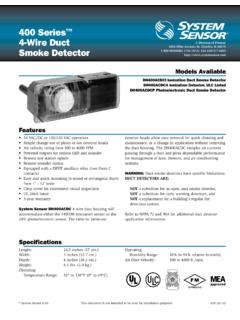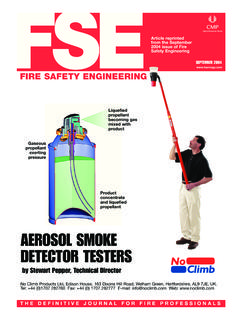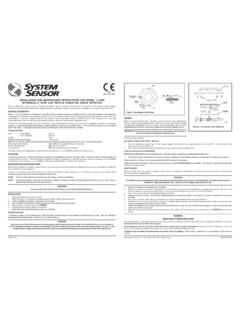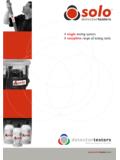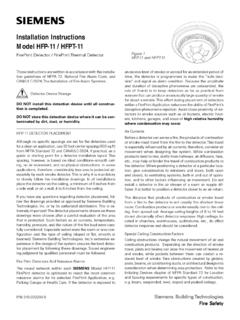Transcription of Bill de Blasio, Mayor Daniel A. Nigro, Fire Commissioner
1 WillYourSmokealarmwakeYouaNDYourFamilYiN themiDDleoFtheNight?MMost fire deathsoccur in themiddle of thenight. A smoke alarm isthe single most valuablelifesaving device youcan have in your operable smoke alarm will reduce your chancesof dying in a fire, nearly in alarms are designed to detect and warn thatsilent, but deadly smoke is in the air. The early warn-ing will wake you and your family, allowing timeto implement your fire escape 97 out of 100 homes have a smokealarm, more than 33 percent of thesehomes are unprotected because thesmoke alarms don't a smoke alarm fails towork, it is frequently because thebatteries are missing. People oftenremove or disconnect batteries toprevent nuisance activation causedby bathroom steam or cookingvapors.*effective april 2014 all newand replacement smoke alarmsin multiple dwellings and pri-vate homes must have a sealed10 year battery that is nonremovable and non replace-able.
2 It must also have anaudible end of life warning . How to protect Yourself, Your Family andYour neighbors Install smoke alarms that have the UnderwritersLaboratories (ul) Mark. The (ul) Marktells you thatthe alarm has been evaluated according to nation-ally recognized safety requirements. In New York City itshould comply with ul 217. There are two kinds of smoke alarm sensors, photo-electric and ionization. ionizationtechnology isbetter at detecting flaming fires with very little smoke ,while photoelectric technology is bet-ter at detecting smoldering fires withheavy smoke . In order to give yourhousehold the optimal protection, it isrecommended you have both technolo-gies in your home. This could be in theform of separate detectors or a combinationalarm with both technologies. One smoke alarm in the home is a smoke alarm on everylevel, including the basement.
3 Place asmoke alarm within 15 feet of all sleepingareas. New construction codes require analarm in every sleeping area and they must beinterconnected so if one is triggered they will allsound the alarm. smoke alarms should beinstalled on the ceiling, prefer-ably in the center of the room,but not less than 4 inches froma wall. If the smoke alarm isinstalled on a wall, it must beplaced between 4 and 12 inchesfrom the & CARBON MONOXIDEALARMSBill de Blasio, MayorDaniel A. Nigro, Fire Commissioner # 8 Fire Department, City of New YorkFireSaFetYeDucatioNproudlY ServinG new York SinCe 1865 SmokealarmSSaveliveScarboNmoNoxiDealarmS SaveliveSSmokealarmSSaveliveSA Public Fire Safety Message From The New York City Fire DepartmentYOURSAFETYISOURMISSIONFDNY carboN moNoxiDe alarmS Save liveS !CCarbon monoxide (CO) is a colorless, odorless, tasteless andtoxic gas.
4 Nicknamed the silent killer , carbon monox-ide is totally undetectable by human senses. Hundreds ofpeople are killed in their home each year by accidental carbonmonoxide poisoning and thousands are permanently injured. Since carbon monoxide is a by-product of incomplete combustion,any fuel-burning appliance, vehicle or tool that is inadequatelyvented or maintained can be a potential source of carbon monox-ide gas. Examples of fuel- burning equipment include: Fuel fired furnaces Gas fueled space heaters* Gas ranges and ovens Gas clothes dryers Charcoal grills Gas water heaters Wood burning fireplaces and stoves Gas fireplaces, both vented and ventless Gas lawnmowers and power tools Automobiles*the use of kerosene or propane space heaters is strict-ly prohibited in nYC. People are at an increased risk of carbon monoxide poisoning dur-ing the winter months.
5 Well-insulated, airtight homes (primarilynewer construction) and malfunctioning heating equipment canproduce dangerously high and potentially deadly concentrations ofcarbon monoxide. why is Carbon Monoxide dangerous?If there is carbon monoxide in the air you breathe, it will enter yourblood system the same way oxygen does, through your lungs. Thecarbon monoxide displaces the oxygen in your blood, deprivingyour body of oxygen. When the carbon monoxide displaces enoughoxygen, you are tHe SYMptoMS oF Carbon Monoxide poiSoninG?Long-term exposure to low concentrationsof carbon monoxidecan gradually build up in the blood causing flu-like symptoms suchas headaches, fatigue, nausea and drowsiness. Since the symptoms of carbon monoxide poisoning are so common,and often misdiagnosed, carbon monoxide poisoning should be sus-pected if more than one member of the family feels ill and if theyrecover after being away from the home for a period of time.
6 Also,illness in your pets preceding illness in a family member may sug-gest carbon monoxide poisoning. Exposure to high concentrationsof carbon monoxide will causethrobbing headaches, breathing difficulties, confusion and loss ofconsciousness, cardiac problems and/or death. Make sure everyone in your home canrecognize and be awakened by thesound of the smoke children and the elderly may not read-ily awake to the sound of the smoke installing interconnected smokealarms so that when one alarm senses smokeand sounds, they are all triggered throughoutyour home. Installing an alarm in each bed-room increases each person s proximity to asounding device. If someone in your homehas a hearing loss, consider complementingyour smoke alarm with a 520Hz beside firealarm and bed shaker device and a highdensity (visual) strobe light.
7 Nuisance alarmsSmoke alarms frequently are set off by bath-room steam or cooking vapors. Rather thantake the battery out of your alarm, dothe following: Quiet the alarm by pushing the HUSH button, if equipped. Open windows and turn on vent fans toclear the air. Consider relocating the alarm farther awayfrom the cooking area or bathroom. Consider installing a photoelectric photoelectric type alarms are less sen-sitive to cooking Your smoke alarM workinG!iiTTiSiSupupTOTOYOu YOu H e S i l e n t smoke alarmS Save liveS !wHoiS at Greater riSk?People may react differently to carbon monoxide expo-sure. Those particularly sensitive are: Senior citizens Infants Young children Pregnant women People with breathing or heart problemsthe First line of defense is preventionYour first line of defense is to prevent or minimize thepotential for exposure to carbon monoxide gas.
8 Have your home-heating systems, fuel-burning appli-ances, flues and chimneys inspected, cleaned andtuned up annually by a qualified technician. Make regular visual inspections of fuel-burning appli-ances such as your gas dryer and hot water heater. Do not burn charcoal inside a home, cabin or camper. Do not operate gasoline-powered engines (generators,cutting saws) in confined areas such as garages orbasements. Do not idle your car inside the garage. During and after a snowstorm, make sure vents for thegas dryer, furnace, stove and fireplace are clear ofsnow build-up. Never use gas ovens and ranges to heat your home!the Second line of defense is a Carbon Monoxide detector alarmYour second line of defense is to purchase and install acarbon monoxide detector alarm. A properly working car-bon monoxide detector alarm can provide an early warn-ing, before deadly gases build up to dangerous levels.
9 New York City law requires that every dwelling unit,including one and two family homes be equipped withcarbon monoxide detector alarms, if there is fossil fuel(oil, natural gas/propane) burning equipment located in,or adjacent to, the building. Effective April 2012, new andreplacement CO alarms must have an audible end of lifewarning. This life safety legislation: Requires that CO detector alarms have the UnderwritersLaboratories (ul) Mark, complying with the require-ments outlined in Standard ul-2034. Requires that existing dwellings install CO detectoralarms that operate on batteries alone or on house-hold electric by a plug-in type with a battery back-up,or are hard-wired to your household electric with abattery back-up. Permits combination smoke and carbon monoxidedetector alarms.
10 Requires that CO detector alarms be installed within15 feet of the primary entrance to all rooms used forsleeping : if you intend to install a combination smokeand carbon monoxide detector alarm to replace yourexisting hard-wired smoke alarm, the combinationdetector alarm must be hard-wired. In addition to complying with the requirements of LocalLaw #7 of 2004, and local Law #112 of 2013, further pro-tect your family by installing a CO detector alarm: On each floor of your home. In bedrooms or sleeping areas if you sleep with closeddoors. In the area of any fuel-burning appliance (more thanfive feet away) such as a furnace or water heater. With a digital display that indicates the CO level. These additional installations will ensure rapid detec-tion of any potentially malfunctioning , do not installa CO detector alarm: Near ceiling fans.










